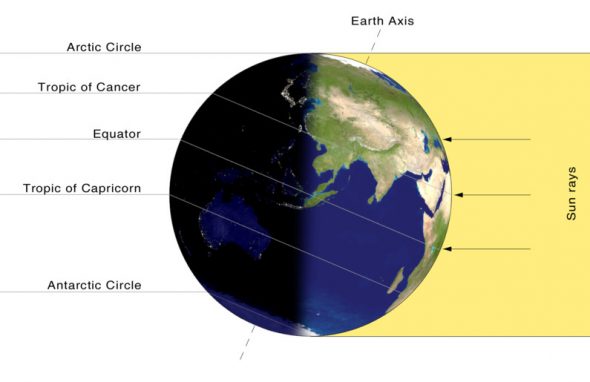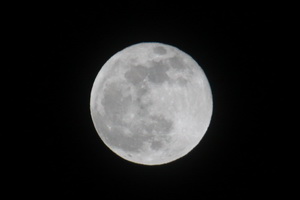|
Category Archives: Astronomy
Summer solstice ushers in astronomical summer, longest day of the year

Astronomical summer arrives in Thornton tonight and with the solstice we will enjoy our longest day of the year.
Summer officially begins at 10:24pm MDT tonight. The Summer Solstice occurs when the North Pole is tilted at it closest to the sun – 23.4 degrees. This results in the longest day of the year in the Northern Hemisphere.
Here in Denver the sun rises at 5:32am today and sets at 8:31pm. This will give us 14 hours, 59 minutes and 14 seconds of daytime. Tomorrow it will be a bit less than one second shorter than today and each day from now through the Winter Solstice in December will get gradually shorter as well.
At the poles of the globe, the seasonal extremes will be quite notable. Areas north of the Arctic Circle to the North Pole will see 24 hours of daylight and have a midnight sun. On the opposite end of the globe, the South Pole will have no direct sunlight at all as they are in the depths of their winter.
Did you know that there is a difference between the astronomical seasons that we are discussing here and meteorological seasons?
Meteorological seasons differ slightly and are geared toward matching the calendar with the annual temperature cycle. This is done primarily for meteorological observing and forecasting and in many ways it is more logical than the astronomical seasons.
For the Northern Hemisphere, the meteorological spring covers the months of March, April and May. Summer brings the hottest months of the year and so meteorological summer is June, July and August. Meteorological fall then is September, October and November followed by the coldest months of December, January and February as meteorological winter.
A whopping seven Earth-size planets were just found orbiting a nearby star
|
Lake Michigan Meteor Lights Up Sky In Several States
|
Astronomical winter to begin Wednesday with the shortest day of the year

Astronomical winter arrives in Thornton early tomorrow morning and with the solstice also comes the shortest day of the year.
Winter officially begins at 3:44am on Wednesday, December 21, 2016. The Winter Solstice occurs when the North Pole is tilted at its furthest from the sun – 23.5 degrees away. This results in the shortest day of the year in the Northern Hemisphere.
Here in Denver, with sunrise at 7:18am and sunset at 4:39pm, our day Wednesday is 9 hours, 21 minutes and 14 seconds long. The day after it will be three seconds longer and each day from now through to the Summer Solstice in June will get gradually longer as well.
While we have a short day on the winter solstice, it is nothing like what will be experienced in the Arctic Circle. Areas north of there to the North Pole will have no direct sunlight at all. Conversely, areas south of the Antarctic Circle toward the South Pole will have 24 hours of daylight and have a midnight sun.
Did you know that there is a difference between the astronomical seasons that we are discussing here and meteorological seasons?
Meteorological seasons differ slightly and are geared toward matching the calendar with the annual temperature cycle. This is done primarily for meteorological observing and forecasting and in many ways it is more logical than the astronomical seasons.
For the Northern Hemisphere, the meteorological spring covers the months of March, April and May. Summer brings the hottest months of the year and so meteorological summer is June, July and August. Meteorological fall then is September, October and November followed by the coldest months of December, January and February as meteorological winter.
John Glenn, First US Astronaut to Orbit the Earth, Dies at 95
|
Elon Musk unveils plans for colonizing Mars
|
ESO Discovers Earth-Size Planet in Habitable Zone of Nearest Star
|
A newly discovered, roughly Earth-sized planet orbiting our nearest neighboring star might be habitable, according to a team of astronomers using the European Southern Observatory’s 3.6-meter telescope at La Silla, Chile, along with other telescopes around the world. The exoplanet is at a distance from its star that allows temperatures mild enough for liquid water to… Continue reading ESO Discovers Earth-Size Planet in Habitable Zone of Nearest Star |
Relieved? NASA opens Planetary Defense Coordination Office
|
If a monster asteroid is headed towards Earth, perhaps the planet is a little more prepared. NASA announced Friday that the Planetary Defense Coordination Office is now open for business, tasked with a succinct mission: to track and characterizing all asteroids and comets that veer too close to Earth – and figure out a response to… Continue reading Relieved? NASA opens Planetary Defense Coordination Office |
2015 brings first Christmas full moon in 38 years
 Christmas 2015 will feature the holiday’s first full moon in 38 years and December 25 won’t see another for 19 more years. The last Christmas full moon occurred in 1977, the next won’t come until 2034.
Christmas 2015 will feature the holiday’s first full moon in 38 years and December 25 won’t see another for 19 more years. The last Christmas full moon occurred in 1977, the next won’t come until 2034.
The Full Cold Moon, as December’s full moon is called, will occur at 4:11am MST early Christmas morning.
According to the Old Farmer’s Almanac, “This is the month when the winter cold fastens its grip and the nights become long and dark. This full Moon is also called the Long Nights Moon by some Native American tribes.”
- Stay up to date with Thornton’s weather: Be sure to ‘like’ us on Facebook, follow us on Twitter and add us to your Google+ circles.
